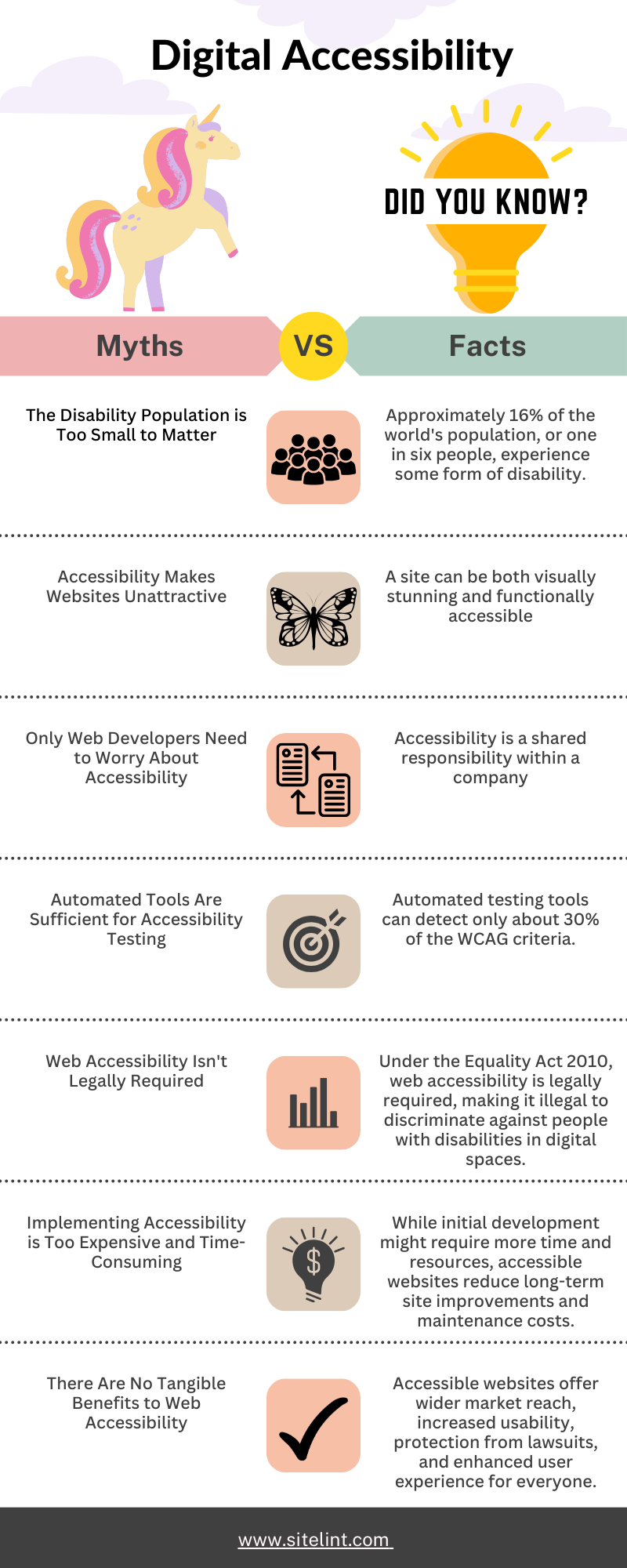Debunk common myths about website accessibility, highlighting the importance of making websites accessible for everyone, not just for compliance.
When auditing a website for accessibility, it’s crucial to distinguish between common myths and the facts. Let’s debunk some prevalent myths and present accurate, enlightening information about web accessibility.
Myth 1: The disability population is too small to matter
Fact: Approximately 16% of the world’s population, or one in six people, experience some form of disability. This significant portion of the population deserves equal access to digital content.
Myth 2: Accessibility makes websites unattractive
Fact: A site can be both visually stunning and functionally accessible. Modern web design and development practices allow for the use of images, videos, and JavaScript, ensuring they are accessible to people with disabilities, as recommended by the Web Content Accessibility Guidelines (WCAG).
Myth 3: Only web developers need to worry about accessibility
Fact: Accessibility is a shared responsibility within a company. While web developers play a crucial role, having buy-in from leadership and adequate resources is essential to supporting accessibility initiatives.
Myth 4: Automated tools are sufficient for accessibility testing
Fact: Automated testing for accessibility isn’t enough because of its limitations. Manual testing by professionals using assistive technology is also crucial for a comprehensive audit. Many cases cannot be tested automatically due to the lack of available technologies to support such a process.
However, automated testing means consistent testing and continuous monitoring at every step of the development of software or digital resources, e.g., PDFs.
Myth 5: Web accessibility isn’t legally required
Fact: In many countries, web accessibility is legally required, making it illegal to discriminate against people with disabilities in digital spaces. For example, Americans with Disabilities Act (ADA), Section 508, European Accessibility Act (EAA) or the Accessibility for Ontarians with Disabilities Act (AODA) or Equality Act 2010 in the United Kingdom.
Myth 6: Implementing accessibility is too expensive and time-consuming
Fact: While initial development might require more time and resources, accessible websites significantly reduce long-term site improvements and maintenance costs. Moreover, they can reach a broader audience, potentially increasing both profit and reputation.
Many frameworks, such as Bootstrap framework, support accessibility well. Using them greatly facilitates and speeds up the implementation of accessibility.
Myth 7: There are no tangible benefits to web accessibility
Fact: Accessible websites offer numerous advantages, including a wider market reach, increased usability, protection from lawsuits, and an enhanced user experience for everyone, not just individuals with disabilities.
You can easily verify this by talking to people with disabilities. Ask them how easy it is for them to navigate the internet.
Call to Action: Elevate your website’s accessibility now
Understanding these myths and facts is critical for a comprehensive and accurate accessibility audit. To achieve this, consider evaluating your website with tools that offer real insights.
One standout solution is the SiteLint Digital Accessibility Audit, which differentiates itself by leveraging real user insights and providing actionable feedback directly in users’ browsers. This unique approach allows SiteLint to efficiently transform websites into universally accessible platforms, thereby broadening engagement and unlocking opportunities previously overlooked due to accessibility barriers.
Crawling is work in the laboratory without user participation. SiteLint works on the user’s side. Thanks to this, you can measure the quality of digital accessibility in a real-world user environment.
Iconographic for Digital Accessibility Myths and Facts


Comments